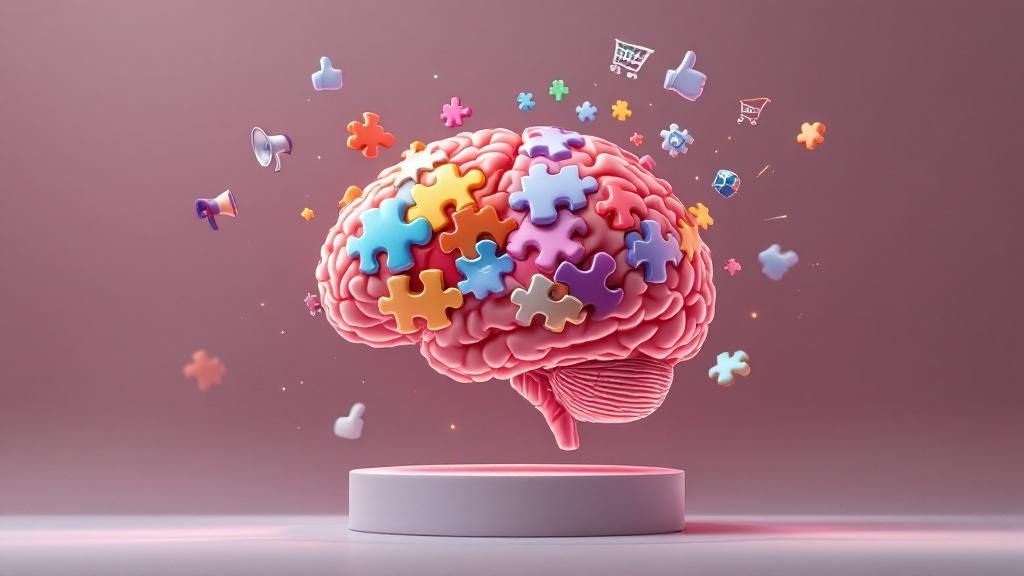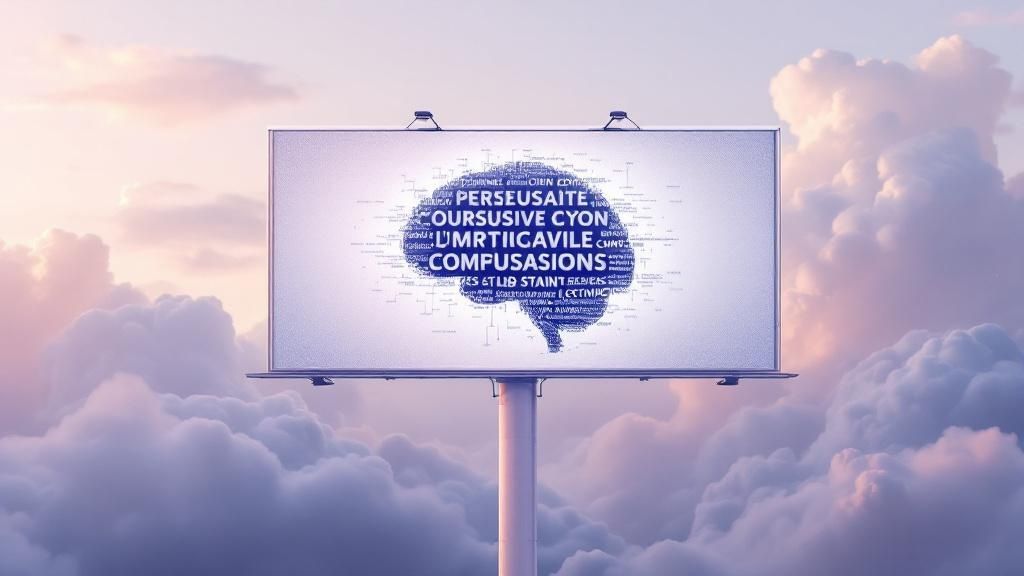
Meta Description: Discover how advertising and psychology intersect. This guide explores key principles like social proof, scarcity, and cognitive biases to help you create ads that truly connect.
Have you ever wondered why a well-funded ad campaign fails, while a simpler one goes viral? The secret often isn't a bigger budget—it's a deeper understanding of psychology. The powerful, often invisible, link between a great ad and the human mind is what separates forgettable content from campaigns that stick. If you're struggling to make your ads resonate, you're not alone. This guide peels back the layers to reveal how the principles of advertising and psychology can help you craft messages that not only get seen but are genuinely felt.
Understanding the Human Element in Advertising

At its heart, advertising is a conversation with the human brain. The campaigns that truly succeed don't just sell a product; they tap into the fundamental human drives, biases, and emotions that steer our decisions every day. As a marketer or creator, shifting your perspective from "selling features" to "connecting with feelings" is a game-changer. This approach allows you to move beyond transactional relationships and build a loyal audience that trusts your brand. It’s the difference between an ad that interrupts and an ad that engages.
How Psychology First Shaped Modern Advertising

To understand today's ads, we need to look back to the early 20th century, when pioneers realized they weren't just selling products—they were selling aspirations and lifestyles. The deliberate fusion of advertising and psychology was a calculated pivot. The goal shifted from listing product features to tapping into our deepest human desires. Advertisers began seeing consumers not as logical decision-makers but as emotional beings driven by subconscious needs. This fundamental shift set the stage for the persuasive marketing we see today, a story you can explore further in the history of psychology in marketing.
The Rise of Persuasive Storytelling
Edward Bernays, often called the "father of public relations," brilliantly applied the psychoanalytic theories of his uncle, Sigmund Freud, to commerce. Instead of just saying a product was good, he built narratives that tied products to powerful concepts like freedom, status, or rebellion. His work for Lucky Strike cigarettes in the 1920s is a prime example. He paid women to smoke in the 1929 New York Easter Parade, framing the cigarettes as "torches of freedom." In one move, he reframed a social taboo into a symbol of female empowerment, shattering a cultural norm and opening a massive new market. This campaign became a blueprint for shaping mass behavior through emotional association.
The Marketer's Toolkit of Psychological Principles
Great advertising isn't magic; it's a craft built on a solid understanding of human psychology. When marketers and creators grasp these core concepts, they gain a toolkit for building campaigns that truly resonate. The goal is to stop listing features and start speaking to the real drivers behind why people make decisions. These principles are effective because they work with how our brains are already wired to process information. Here’s a quick rundown of some key principles and how they show up in the wild.
Key Principles and Their Applications
| Psychological Principle | Core Concept | Real-World Use Case for Creators & Marketers |
|---|---|---|
| Social Proof | We trust and adopt the actions and opinions of the majority. | An agency showcasing client testimonials and logos on its homepage to build instant credibility. |
| Scarcity | We place a higher value on things that are limited or in short supply. | A freelancer offering a "limited-time" discount on a service package to encourage quick sign-ups. |
| Emotional Appeal | Decisions are often driven by feelings rather than logic. | A startup's ad telling a heartwarming story about its mission, focusing on impact over product features. |
| Reciprocity | We feel an obligation to give back when we receive something first. | A content creator offering a free, valuable e-book in exchange for an email subscription to build an audience. |
| Color Psychology | Different colors evoke specific emotions and associations. | A tech company using blue in its branding to signal trust, stability, and professionalism. |
Tapping into Social Proof and Scarcity
Two of the heaviest hitters in advertising and psychology are social proof and scarcity because they tap into our desire to belong and our fear of missing out (FOMO). For creators and marketers, these are essential tools.
- Social Proof in Action: A digital marketer might feature a "Customers Love Us" section with screenshots of positive tweets, or an influencer could post user-generated content of followers using a sponsored product. These actions turn customers into advocates.
- Scarcity in Action: An e-commerce brand can use a "limited edition" drop to create buzz and urgency. Similarly, a course creator might open enrollment for "only 72 hours" to drive immediate action from their email list.
The Power of Emotional Appeals and Reciprocity
We think we're logical, but emotion often drives our decisions. Ads that make us feel joy, nostalgia, or inspiration forge a connection that a list of benefits never could. A solopreneur's brand story about overcoming challenges resonates more deeply than a simple service description. That emotional footprint is what turns a one-time client into a loyal fan. Then there's reciprocity: give value first. A marketing agency offering a free website audit or a content creator hosting a no-cost webinar builds goodwill. This makes a future purchase feel like a natural next step, not a hard sales pitch.
👉 Try MediaWorkbench.ai for free – schedule your posts and generate AI content in one place!
Using Cognitive Biases to Guide Consumer Choice

Beyond broad principles lies a more subtle toolkit: cognitive biases. These are mental shortcuts our brains use to make decisions quickly. For marketers, understanding these biases isn't about manipulation; it's about presenting choices in a way that feels natural and intuitive, simplifying the buying process. When used ethically, they can make your offer's value crystal clear and help guide customers to the best solution for their needs. Check out these fascinating marketing psychology facts and statistics to see how predictable our choices can be.
The Decoy Effect in Action
The Decoy Effect occurs when you introduce a third, slightly less appealing option to make one of your original options look like a fantastic deal. It changes the frame of reference for the decision.
- Use Case for a SaaS Startup: Imagine offering two subscription tiers: a Basic Plan for $10/month and a Pro Plan for $20/month. To make the Pro Plan more attractive, introduce a decoy: a "Basic Plus" Plan for $18/month with only minor additional features. Suddenly, the Pro Plan looks like a steal—for just $2 more, you get everything. The decoy's only job is to make the Pro Plan the obvious winner.
Setting the Anchor for Perceived Value
Anchoring is our tendency to latch onto the first piece of information we see and use it as a reference point. That first number becomes the "anchor" that defines our perception of value.
- Use Case for a Freelancer: A freelance designer quoting a project could present a premium, all-inclusive package first. Even if the client chooses a more modest mid-tier option, that initial high anchor makes the final price seem much more reasonable. It frames the value conversation from the start. Pairing these nudges with smart automation can be powerful; see our guide on marketing automation best practices to learn more.
How Digital Advertising Amplifies Human Psychology
The internet didn't invent psychological influence—it just put it on steroids. Timeless principles of persuasion are now supercharged by data and algorithms, creating a potent mix of advertising and psychology that shapes our online experience. What used to be a one-to-many broadcast is now a personalized, one-to-one conversation. This shift began long ago, as detailed in this UNL research paper, but today's algorithms have perfected it. They analyze your clicks, searches, and past purchases to predict what you’ll want next, enabling a level of personalization that was once science fiction.
Social Proof and Algorithmic Targeting
Digital platforms have hardwired psychological principles into their features. Every like, share, and review amplifies social proof on a global scale.
- Influencer Marketing: A modern-day celebrity endorsement where trust is transferred from a creator to a product.
- Algorithmic Targeting: A small business can now run Facebook ads that are shown only to users who have visited their website, shown interest in similar products, and live within a 10-mile radius. Each ad can be tailored to that specific user's psychological profile, ensuring the message is as relevant as possible.
This micro-targeting allows even small creators and startups to compete by ensuring their message hits the perfect audience segment at the perfect moment. To learn more, check out our deep dive into social media automation software.
Drawing the Line Between Persuasion and Manipulation
Using psychology in advertising carries a massive responsibility. There’s a critical line between ethical persuasion and outright manipulation. Persuasion guides a customer toward a choice that genuinely helps them, building trust through transparency and value. Manipulation, on the other hand, preys on insecurities, creates false anxiety, or uses deceptive design to trick users. While cheap shots like "dark patterns" (e.g., hidden subscription fees) might offer a short-term win, they destroy brand trust and long-term viability. Ethical marketing isn't just about avoiding trouble; it's the only sustainable strategy for growth. Master honest, persuasive communication by checking out our guide on SEO copywriting tips.
The conclusion is clear: the brands that win are those that use the principles of advertising and psychology to build genuine relationships, not just to chase a quick sale.
Turning Theory Into Results
We've explored the fascinating intersection where advertising and psychology meet, and the main insight is clear: great marketing isn't about shouting the loudest; it's about understanding people and forging a genuine connection. From foundational principles to modern digital tools, everything points back to the human mind. By moving beyond just chasing clicks to building real relationships, you can create campaigns that resonate long after the screen goes dark. It's your turn to apply these concepts—start thinking about the why behind your audience's choices and craft experiences that truly stick.
Ready to put these powerful psychological principles into practice? MediaWorkbench.ai provides the tools you need to generate compelling AI content, create stunning visuals, and schedule posts that connect with your audience on a deeper level. start your free trial at mediaworkbench.ai.

